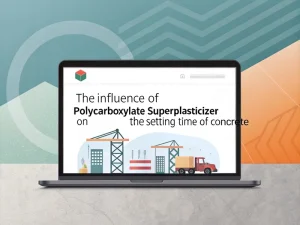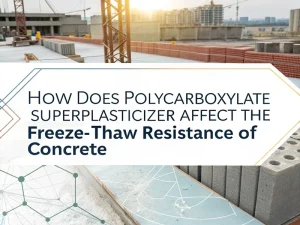
The Influence Of Polycarboxylate Superplasticizer On The Setting Time Of Concrete
Blog The influence of pol
Blog
The fluidity of concrete directly determines construction efficiency and pouring quality. Whether it is pumping pre-mixed concrete to fill high-rise building templates or wrapping dense steel bars with self-compacting concrete, good fluidity is the core prerequisite for ensuring the uniform formation of concrete and reducing internal defects. Although traditional water reducing agents such as naphthalene series and lignosulfonates can improve flowability, they often face problems such as “short flowability maintenance time” and “rebound in water demand”.
Polycarboxylate Superplasticizer Powder (PCE Powder), as the third-generation high-performance water reducer, is the core technology to solve this challenge. It revolutionised the flowability of concrete with its excellent dispersibility and slump retention performance, enabling it to easily meet the performance requirements of self-compacting and high flowability.
The fluidity of concrete refers to the ability of freshly mixed concrete to flow, deform, and maintain uniform density under its own weight or external vibration. It is usually measured by slump or slump flow. Good fluidity means that concrete is easy to pump, pour, vibrate, and smooth, ensuring construction quality and efficiency.
The following indicators are commonly used in engineering to measure the fluidity of concrete, and different scenarios correspond to different requirements:
Slump: Suitable for ordinary pumped concrete, such as beams, slabs, and columns in high-rise buildings, typically requiring a slump of 100-150mm;
Slump Flow: For self-compacting concrete (SCC), the template can be filled without vibration, with a target expansion of 650-800mm;
Inverted cone time: commonly used for dry and hard concrete (such as road paving), the flowability is determined by the time it takes for the concrete to flow out of the inverted cone tube, generally requiring 5-15 seconds.
Concrete without added water-reducing agents, due to the tendency of cement particles to aggregate, requires a large amount of mixing water to achieve basic fluidity, but it can lead to two major problems:
Elevated water cement ratio: Excess water evaporates and leaves pores, reducing the strength and durability of concrete.
Rapid attenuation of fluidity: The hydration reaction of cement continuously consumes water, and the slump may lose more than 50% of its original volume within 1 hour, which cannot meet the requirements for long-distance transportation or complex pouring.
Although traditional liquid water-reducing agents can alleviate these problems, they have limitations, such as high transportation costs, easy storage deterioration, and inflexible dosage adjustment. PCE powder can precisely address these shortcomings and optimise fluidity from the root.
The reason why PCE powder can efficiently improve and maintain the fluidity of concrete is due to its unique “comb-like molecular structure” and precise effect on cement particles – through the triple effects of physical adsorption, electrostatic repulsion, and spatial hindrance, it breaks cement agglomeration, releases free water, and achieves “improvement+long-term maintenance” of fluidity.
Cement particles have a positive charge on their surface and are easily attracted to each other by electrostatic attraction in water, forming “aggregates” that encapsulate a large amount of water inside the aggregates, resulting in insufficient free water and thickening of the concrete.
The molecular chain of PCE powder consists of a “main chain” and a large number of “side chains”:
Traditional water-reducing agents rely solely on electrostatic repulsion. As the hydration process of cement progresses, the ion concentration in the solution increases, and the electrostatic repulsion between the ions gradually weakens. Cement particles are prone to re-aggregation, leading to a rapid decline in fluidity (i.e., “slump loss”).
The “side chain” of PCE powder plays a crucial role:
The hydration reaction of cement will continuously consume water and generate hydration products (such as ettringite and hydrated calcium silicate), which will increase the viscosity of concrete and accelerate the loss of fluidity.
PCE powder can moderately regulate the hydration process of cement:
Delaying early hydration: PCE molecules adsorb onto the surface of cement particles, which can slightly hinder the contact between water molecules and cement minerals (such as C3A and C3S), slowing down the early hydration heat release and product generation rate.
Extended working window: Moderate reduction in hydration rate allows concrete to maintain a “flowable” state for a longer period of time, especially suitable for pouring in high-temperature environments (>30 ℃) or complex structures (such as large volume concrete, ultra-long pumping).
The influence of PCE powder on the flowability of concrete is mainly reflected in two aspects:
PCE powder can achieve extremely high initial slump or slump expansion of fresh concrete at lower water-cement ratios.
Application: This enables concrete to be easily used in projects with long pumping distances and high heights, as well as in self-compacting concrete (SCC) and high-strength concrete (HPC) structures that require high fluidity.
During transportation and while waiting for the concrete to be poured, the cement will continue to hydrate, resulting in a gradual loss of fluidity (slump loss). The molecular structure design of PCE enables it to continuously adsorb and desorb on the surface of cement particles, effectively delaying slump loss.
Application: Excellent slump retention is crucial for long-distance transportation, high-temperature construction, or projects that require longer pouring times. It ensures that the concrete maintains the required fluidity during pouring, avoiding quality degradation caused by on-site water addition.
polycarboxylate superplasticizer powder, through the triple mechanism of “adsorption dispersion spatial hindrance hydration regulation”, can not only significantly improve the initial flowability of concrete, but also maintain workability for a long time. At the same time, it offers the advantages of flexible dosage, convenient storage, and good compatibility, effectively addressing the pain points of traditional water-reducing agents in flowability optimisation.
In practical applications, as long as the dosage is precisely controlled, the mixing process is optimised, and the material characteristics are adapted, its value can be fully realised, providing stable fluidity guarantees for different scenarios, such as ready-mixed concrete, self-compacting concrete, and dry-hard concrete.

The Influence Of Polycarboxylate Superplasticizer On The Setting Time Of Concrete
Blog The influence of pol

How Does Polycarboxylate Superplasticizer Affect The Freeze-thaw Resistance Of Concrete?
Blog How does polycarboxy